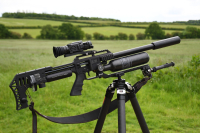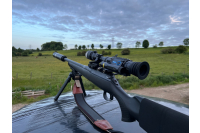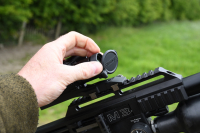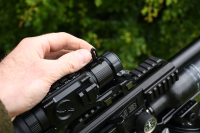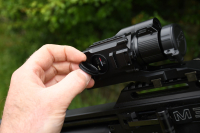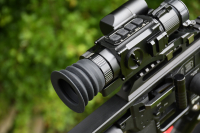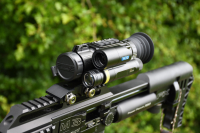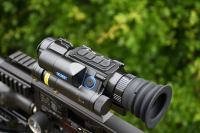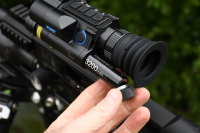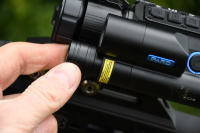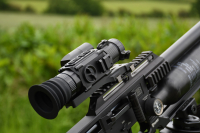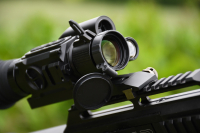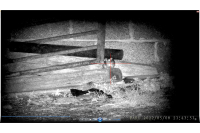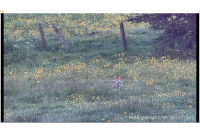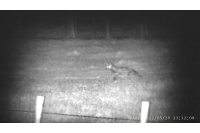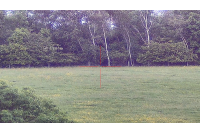PARD NV008S and NV008S LRF
I was lucky to bring an early version of the latest PARD NV008S night vision scope back from the British Shooting Show in February and have since received the full production version in both variants, one with and one without the laser rangefinder. Both units are class 3 laser products and fully certified safe to comply with British Standards which is the reassuring factor to consider when assessing laser infra-red illuminators. Essentially, the only difference between these two is that the “LRF” has an additional bulge on the left upper side, housing the laser emitter for the rangefinder. Rangefinding is accessed with the second of the four buttons on top and rated from 3.5-1200metres, a range I haven’t fully retested in the filed but certainly had no problem in full daylight just past 650 metres with the internal displaying either yards or metres as you prefer.
To cover the shared functions in detail, the box includes a soft cloth storage bag and cordura carry case. Also included are USB C charging cable, lithium-ion battery, Allen keys, mount shims and a Picatinny mount. This attaches to the PARD’s underside in multiple locations offering a wide range of linear position on the rifle and with steel inserts in the aluminium body’s underside, easily tensioned with firm assurance. The Picatinny itself fastens with a socket or Allen keys and I was confident with the mechanical build when I felt torque applied, screws meeting their stops and limits immediately, without a squishy feel of weak aluminium threads gasping towards the end of their lives. There are also a pair of slim metal shims to fit between mount and body if you find more or less elevation is required.
First off, remove the small adhesive electrical contact insulator from the top of the 18650 battery, this fits under smoothly threaded cap on the left side with notably smooth threads for easy silent swap over. This battery is charged in the PARD with the USB cable plugged in to the right side underneath a finger accessible screwcap that also shields the Micro SD card slot for recording video and stills. Sound is also recorded. Once switched on with a long hold of the left side blue rimmed button, you focus the screen via the collar wrapping the ocular lens below the bellows eyecup. The objective lens is protected under a flip up aluminium cap and target image focus is with an aluminium collar around the objective lens which now has a handily hinged throw lever for easier tactile recognition in the dark, and finer control of precise image focus. The internal screen features 30 frames per second refresh rate with 1024x768 pixel resolution. Image resolution from the sensor for output video is 1920x1080 and I found the image to appear smooth flowing without noticeable lag or latency. Optical magnification is 6.5x which can be digitally boosted to 13x with the upper front button, and/or with a PIP (picture in picture) display permanently on screen.
Instructions are reasonably detailed, and I found operation fully reliable when zeroing the scope. There are 5 rifle profiles and there is also a ballistic calculator on both, although this is only of specific use on the LRF version, more about that later. Zeroing uses the freeze frame, moving reticle system and there are multiple reticle and colour choices to best suit your eyesight and background colour contrast of the image. Other menu functions include automated recording (where the unit begins to record the instant it powers up), picture in picture, range unit selection and gyroscope (inclination and CANT display as well as compass bearing). Default settings are available for colour and magnification as well as IR intensity, so the unit returns immediately to all preferred setting the instant it is enabled, to save time for likely common usage scenarios with least immediate input required. The second menu screen offers three internal screen intensity levels, auto and loop recording, the latter of which will retain 3-, 5- or ten-minute clips. You can set the unit to pre-record for recoil activation as well as adding a time and date stamp to output footage. Audio recording can be switched on and off, as well as bleeping noises from the scope button presses which I immediately de-activated. There is also wi-fi on/off for app connectivity. The third menu stage offers exposure level control for image quality, language options, date/time setup and the ability to format the SD card and return before lastly, default settings and firmware version.
If you do choose the LRF version, here is where the Ballistic capability proves it’s worth. Pressing the second top button LRF control initiates the system, firing the laser and displaying range to target. A second press runs the ballistic computer within, and you get an almost instantaneous holdover reticle displayed under the main aimpoint to illustrate where to hold for corrected point of impact at that range. So, if you zero at 100 metres and range/calculate a target at 200, the holdover will be seen below, now for use as your new aimpoint. This can be chosen from three options, X, line, or small box and with various colours too. The success of the calculated solution is pretty good but like all ballistics calculators, dependant on the quality of the information you feed in and checking it’s working and refining it before you go hunting. The five ballistic setup options can be saved with labels A-E, and each requires velocity, bullet weight, ballistic coefficient, altitude, temperatures, scope height above the bore, zero range and individual preferred holdover marker shape and colour. There is no restriction on values and items like B.C. can be entered to 3 decimal places, so the system is precise and I have used it with airguns, rimfire and centrefire with no problems in hunting scenarios.
So, for real world use, how have they been, well I put the LRF version on the FAC airgun as that was getting the most multi range use and of course, the curviest trajectory to compensate for on generally small quarry. I used the non LRF version on a 223-foxing rifle where I have a point blank zero range and if ever required, use small amounts of visual holdover to compensate for extended ranges, on what is a flatter trajectory projectile for generally larger quarry and vital zones. I have found both units to work as described and feel the image quality and illuminators are particularly more effective than older models. The left side illuminator has three intensity levels when switching to black and white mode after dark. There is a telescopic adjusting collar on the lens and it’s all that’s needed for ranges out to about 75 metres. If there is a decent moon or ambient light, the sensor offers phenomenal image quality but in full darkness, I added a larger illuminator, there is a right side Picatinny mounting point for this if you don’t have a mount on the rifle itself. Because on-board IR runs from the same 18650 battery, the suggested 8-hour life has to be taken in context of how much IR you use and internal screen brightness, temperature, laser usage etc. A short press on the blue ringed on/off button switches the unit off temporarily to save battery, a long hold shuts it down completely. I found total power up was about 4 seconds so had no worries turning the unit off to save batteries for a four hour night out with spare capacity left `in the tank`. The lower right battery life indicator was quite reliable and swapping the battery or using an external USB power pack is no problem at all, plugged into the USB-C port.
Focal control is quick and intuitive with the raised throw lever simplifying access, all buttons are on top now, rather than being inclined to the left side, they are rubberised, tactile and silent in use with shaped recesses to aid finding the button you need in the dark. As well as night vision capability, it’s not to be forgotten just how well this works in full daylight in colour mode, you don’t really need to use a day scope and I have found the 008s confident for zeroing easily, for ammunition testing/tuning/selection and target use whereas of old, night vision scopes were awkward, if not at all functional in daylight for casual non hunting use. Where the PARD really surpasses expectation is at dusk as natural light dwindles, you can remain in colour mode, see, and engage appropriate quarry far beyond light conditions where even the finest daylight scopes can remain functional and believe me, I have used some of the finest. The image is a little grainer as light fades and ISO (sensor sensitivity) is increased but it’s still usable for hunting. I shot pigeons at dusk, foxes at dusk, Rats in complete darkness and Foxes similarly so. The Foxes were over grass pastures with little IR reflection issues, but Rats immersed among farmyard debris can be hidden by excess IR reflecting unnecessarily and dimming the image. Not the case here as although compact and easily dismissed, the on-board PARD IR is incredibly softly focussed, without harsh reflections, it bathes quarry gently in 850 nM light rather than over flooding them! The light field is circular without graduations across it either. With the centrefire, I was able to see Hares well beyond 200 metres, I wasn’t shooting them but aiming precision would have allowed it and it was only when there was no ambient light at all that I switched to the external IR giving me 350 metre precision range on a Hare and 300 for a Fox with total confidence. My favourite IR illuminator is currently gone for repair and the backup choices available to me have restricted me slightly as given the mid-range capability of the new 008s, I would feel assured that with my usual Illuminator, it would have exceeded the capability of the older Pard 008. The LRF is useful, the ballistic calculator is extremely helpful for extended shots, and I think PARD have taken a strong step forward with a unit that is still super compact at just 182mm long weighing 445gr. It’s not just for larger rifles, it’s perfectly suited to compact rimfires and airguns too without restricted ergonomics. Warranty is three years, and I will happily continue using these optics across a variety of rifle projects because at no time has it let me down, failed to record important footage or failed to give me a confident id on any quarry for a reassuring shot to take place without excessive effort to master the controls or balancing illuminator intensity repetitively.
Photo captions
- PARD 008s LRF in use on an FX Impact
- PARD 008s on a 223 Sauer foxing rifle
- Aluminium lens cap
- Flip up throw lever
- Charging and SD card slots are now protected by fingertip removable screw cap
- Bellows eyecup offers approximately 35mm eye relief
- Left side of the LRF shows upper laser housing above the illuminator
- Soft buttons operate in silence
- 18650 removable battery compartment
- Telescopic illuminator focal adjuster
- Picatinny mounting offers great linear positioning versatility
- Objective lens and throw lever detail
- Screenshot from video footage, of a Rat at ~25 metres (008s LRF)
- Screenshot from video footage, Daylight fox at ~160 metres (008s)
- Screenshot from video footage, fox after dark at ~70 metres (008s)
- Screenshot from video footage, rangefinding result (008s LRF)
- Screenshot from video footage, holdover aimpoint displayed (008s LRF)

